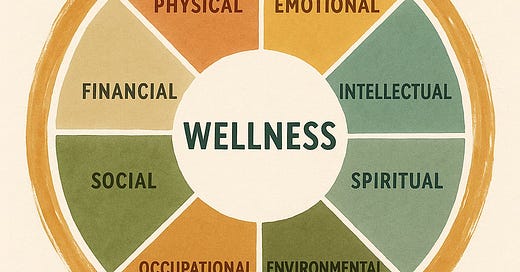Introduction
What if health wasn't a single state to be achieved, but a set of dynamic relationships constantly in motion?
That was the insight behind Dr. Bill Hettler’s 1976 Six Dimensions of Wellness model—one of the earliest frameworks to suggest that health should be seen not as an endpoint, but as an interdependent system of physical, emotional, intellectual, spiritual, social, and occupational domains[1]. It was a radical departure from the medical model of the time. Instead of defining wellness as the absence of disease, Hettler proposed it as the presence of purpose and balance.
Since then, our understanding of wellness has deepened. The forces that shape well-being—economic insecurity, climate anxiety, burnout—have expanded. And so too has the model. Today, many practitioners and organizations work from an 8 Pillar Model of Wellness, introduced by Dr. Margaret Swarbrick, which integrates two essential modern domains: financial wellness and environmental wellness.
This essay traces that evolution—from six to eight—and explains why the 8 Pillar model, assessed through the Wellness Inventory, is a better fit for the complex lives we actually live.
The Original Blueprint: Six Pillars That Started a Movement
In the 1970s, public health was mostly reactive. You got sick, then got treated. Hettler, a physician and visionary at the University of Wisconsin-Stevens Point, argued for something more proactive, more human.
He drew from:
Halbert Dunn’s idea of "high-level wellness"[2]
Maslow’s hierarchy of needs
The YMCA’s body-mind-spirit triangle
The optimism of humanistic psychology[3]
He ultimately proposed six equal dimensions—Physical, Emotional, Intellectual, Social, Spiritual, and Occupational—arranged like spokes on a wheel. Each influenced the others. None could be ignored. His model, adopted by the National Wellness Institute in 1977, became the template for campus health programs, employee wellness initiatives, and personal development workshops across the country.
But it was never meant to be static.
New Pressures, New Dimensions: The Shift Toward Eight
As society evolved, cracks appeared in the six-spoke wheel. Two blind spots became impossible to ignore:
Financial instability wasn’t just stressful—it was a driver of chronic illness, relationship strain, and mental health issues[4].
Environmental degradation wasn’t just ecological—it was personal, affecting air, food, water, and psychological well-being[5].
Dr. Margaret Swarbrick, a clinical psychologist and pioneer in peer-led mental health recovery, proposed adding these two missing pieces. Her 8 Dimensions of Wellness model was adopted by organizations like SAMHSA and became a cornerstone in community health and integrated care[6].
Her insight was this: true wellness requires a safe, stable world in which to flourish. Without addressing money or the environment, no internal growth could be sustained.
The shift from six to eight wasn’t cosmetic—it was a redefinition of what counts as health.
The 8 Pillars of Wellness
Here’s a snapshot of the evolved model, now increasingly used in integrative health, behavioral medicine, and personal coaching contexts:
Physical – Care for the body through movement, nutrition, rest, and preventive health
Emotional – Awareness and expression of feelings, and the capacity to manage stress
Intellectual – Lifelong learning, curiosity, and creative pursuits
Social – Building supportive relationships and community
Spiritual – Cultivating purpose, meaning, and values-driven living
Occupational – Engaging in fulfilling work and maintaining work-life balance
Financial – Managing resources to feel secure, reduce stress, and plan for the future
Environmental – Living in and contributing to safe, sustainable, and healthy surroundings
Each dimension is dynamic. Strength in one area can buffer weakness in another. And breakdowns often start where we’re least paying attention.
Measuring What Matters: The Wellness Inventory
Abstract models are only useful if they can be turned into action. That’s where the Wellness Inventory comes in—a validated self-assessment tool based on Swarbrick’s 8 Pillars that transforms personal reflection into measurable insight[7].
Unlike one-dimensional wellness quizzes or symptom trackers, the Wellness Inventory asks deeper, behavior-based questions across all eight dimensions. It doesn’t just ask how you feel. It examines what you do, where you focus, and how aligned your life is with your values.
It is especially well-suited for:
Baseline self-assessments
Coaching or therapy interventions
Tracking change over time
Lifestyle redesigns during transitions
“Wellness” is a word. The Inventory gives it structure.
I'm working on a new initiative I'm calling Well-IQ. Swarbrick's Wellness Inventory will anchor the process—serving as both a mirror and a compass.
Well-IQ: A Framework for Insightful Living (coming soon)
Well-IQ is a new approach to wellness—not a supplement, not a slogan, but a framework designed to deepen personal insight and spark intelligent growth. Building on the foundations of the Eight Pillars and the lived experience of transition and reinvention, Well-IQ encourages each person to engage with their own well-being through curiosity, accountability, and pattern recognition.
It doesn’t assume wellness is linear—or even tidy. It acknowledges that well-being evolves in fits and starts, along a non-linear path marked by uncertainty, renewal, and the occasional detour. If you’ve ever sensed that growth comes on a meandering road, not a straight one, you’re in the right place.
Well-IQ invites reflection:
What are the patterns in your energy, focus, and purpose?
What gets neglected when life gets busy?
Which of your strengths could become anchors during change?
This initiative is grounded in evidence, but it’s designed to feel personal. Rather than flooding users with goals or checklists, it asks better questions. It creates space for insight. It supports the shift from knowing what’s good for you to actually doing it—gently, consistently, and in a way that sticks. It’s wellness, rewired.
In the months ahead, I'll announce more details about Well-IQ and will be looking for subscribers interested in a free sneak-peak.
Stay tuned.
References
Dunn HL. High-Level Wellness. Arlington, VA: Beatty Press; 1961. ↩︎
American Psychological Association – Stress in America Survey ↩︎
Harvard T.H. Chan School of Public Health – Climate Change and Health ↩︎
SAMHSA – Promoting Wellness for Better Behavioral and Physical Health ↩︎
Rutgers – Mapping Mental Health: Swarbrick’s Wellness Model↩︎





Looking forward to the Well-IQ roll out!